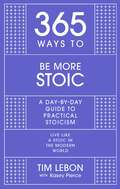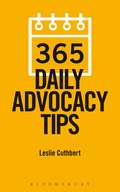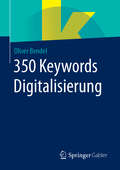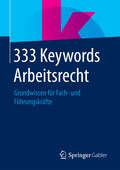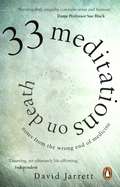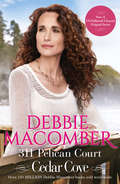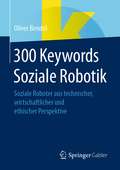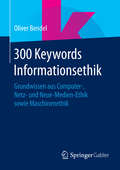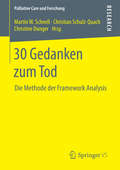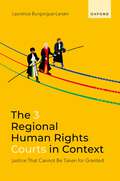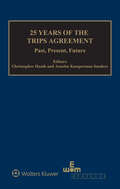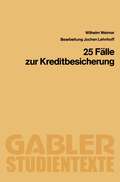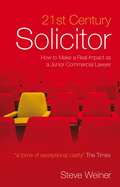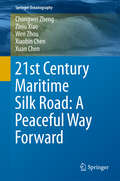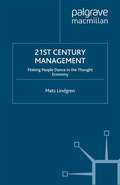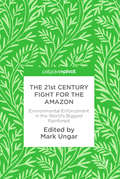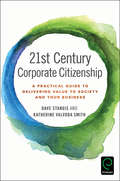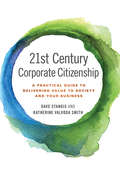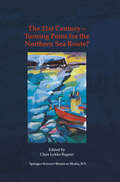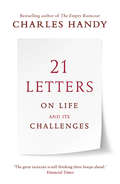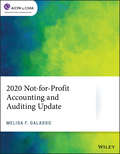- Table View
- List View
365 Ways to be More Stoic: A day-by-day guide to practical stoicism
by Tim LebonHAPPINESS, SERENITY AND FULFIMENT ARE ALL WITHIN YOUR CONTROL365 WAYS TO BE MORE STOIC is a full year's worth of daily inspiration, tools, stories, actions, and rituals that will guide you to a meaningful life, filled with happiness. It is a simple, list-driven, practical guide that will allow you to immediately begin putting Stoic wisdom into practice in your daily life. Each short chapter makes Stoicism fun to read about and easily digestible, presenting ideas in engaging, bite-size chunks.Immerse yourself in stoicism right from the first chapter, through prompts, concepts, challenges, inspiration, quotes, examples, quizzes and case-studies. You'll learn to navigate through the controllable and inevitable. You'll develop constructive ways to handle frustration, adversity and even your own mortality. You'll learn habit-forming strategies, pick up helpful concepts, and uncover tips for lasting change. This fun and engaging manual will help you live like a Stoic in the modern world. 365 WAYS TO BE MORE STOIC focuses on the small stuff you can do every day to live a happier and wiser life. Because when you get the little things right, the big things follow.
365 Daily Advocacy Tips
by Leslie Cuthbert“This book is a good idea…What I like is there will be one idea every day – and only one. Your mind will not get jumbled. Think on what you read…. Some ideas you will like. Others may not work for you. With advocacy, this is always the way. But the point is to try things out – one day at a time.”Iain Morley QC, author of The Devil's Advocate, from the Foreword to 365 Daily Advocacy Tips365 Daily Advocacy Tips is packed with pithy, serious, amusing, and thought-provoking tips for each day of the year, from a refreshingly diverse range of sources. Providing a fascinating insight into the principles of good advocacy, it also contains essential knowledge of related topics such as how people make decisions, indicators of credibility and the 'rules' of argument and rhetoric.Unlike most texts on advocacy 365 Daily Advocacy Tips provides an insight to psychology and how to break down the rules of argument and rhetoric. It also covers acronyms to help remember techniques, useful quotes from history and literature that can be used in cases and references to other texts both legal and non-legal.Lengthy and studious volumes of advocacy have their place, but sometimes just one morsel of advice is needed to change an entire day's work. This calendar of tips and tales from the world of advocacy will prove an able companion for every advocate serious about continuous and incremental improvement in their knowledge, skill and practice.
350 Keywords Digitalisierung
by Oliver BendelVon „Big Data“ über die „Künstliche Intelligenz“ bis hin zur „Sozialen Robotik“: Im Kontext der Digitalisierung gibt es unzählige Fachtermini. Das vorliegende Nachschlagewerk ist für alle geeignet, die einen schnellen Einstieg in das Gebiet der Digitalisierung suchen und sich für Fragen der Ethik interessieren. In 350 übersichtlichen Beiträgen werden die Grundlagen und Entwicklungen leicht verständlich erläutert.
333 Keywords Arbeitsrecht: Grundwissen für Fach- und Führungskräfte
by Springer Fachmedien WiesbadenVon der Abfindung über Direktionsrecht, Jobsharing, Mankohaftung und Pflichtquote bis zur Zulage: Die Sprache des Arbeitsrechts zeichnet sich durch unzählige Fachbegriffe aus. Einen ersten schnellen Überblick verschafft das vorliegende Nachschlagewerk. Anhand von 333 übersichtlichen Schlüsselbegriffen werden die Grundkonzepte des Arbeitsrechts erläutert. Die Erklärungen sind kompakt und verständlich formuliert und bieten somit Basiswissen für alle, die einen schnellen Einstieg in die Thematik suchen, sich für arbeitsrechtliche Fragen interessieren oder ihr vorhandenes Wissen auffrischen möchten.
33 Meditations on Death: Notes from the Wrong End of Medicine
by David Jarrett_________________“Brilliant - a grimly humorous yet humane account of the realities of growing old in the modern age. Everybody over the age of 60 should read it and ponder their probable future.” - Henry MarshWhat is a good death? How would you choose to live your last few months? How do we best care for the rising tide of very elderly? This unusual and important book is a series of reflections on death in all its forms: the science of it, the medicine, the tragedy and the comedy. Dr David Jarrett draws on family stories and case histories from his thirty years of treating the old, demented and frail to try to find his own understanding of the end. And he writes about all the conversations that we, our parents, our children, the medical community, our government and society as a whole should be having.Profound, provocative, strangely funny and astonishingly compelling, it is an impassioned plea that we start talking frankly and openly about death. And it is a call to arms for us to make radical changes to our perspective on ‘the seventh age of man’.
311 Pelican Court: 16 Lighthouse Road; 204 Rosewood Lane; 311 Pelican Court; 44 Cranberry Point; 50 Harbor Street; 6 Rainier Drive (A Cedar Cove Novel #3)
by Debbie MacomberPerfect for fans of Maeve Binchy' - Candis Welcome to Cedar Cove – a small town with a big heart!
31 Bond Street: A Novel
by Ellen HoranBased on a true story, mystery and intrigue in pre-Civil War New York
300 Keywords Soziale Robotik: Soziale Roboter aus technischer, wirtschaftlicher und ethischer Perspektive
by Oliver BendelDas vorliegende Nachschlagewerk sammelt und erläutert Begriffe rund um Soziale Robotik und Automatisierung. Es ist für alle geeignet, die einen schnellen Einstieg in das Gebiet suchen und sich besonders für Fragen des Zusammenspiels von Mensch und Maschine sowie Fragen der Ethik in diesem Bereich interessieren. In über 300 übersichtlichen Beiträgen werden die Grundlagen und Entwicklungen leicht verständlich erläutert.
300 Keywords Informationsethik: Grundwissen aus Computer-, Netz- und Neue-Medien-Ethik sowie Maschinenethik
by Oliver BendelVom „Altruismus“ über die „Filter Bubble“ bis hin zum „Whistleblowing“: Die Sprache der Informationsethik zeichnet sich durch unzählige Fachtermini und Anglizismen aus. Das vorliegende Nachschlagewerk eignet sich für den ersten schnellen Überblick. In 300 übersichtlichen Beiträgen werden die Grundlagen erläutert. Die Erklärungen sind verständlich formuliert und bieten Basiswissen für alle, die einen schnellen Einstieg in die Grundfragen der Informationsgesellschaft suchen und sich für Informationsethik interessieren.
30 Gedanken zum Tod: Die Methode der Framework Analysis (Palliative Care und Forschung)
by Martin W. Schnell Christian Schulz-Quach Christine DungerDie Autoren stellen das Projekt „30 Gedanken zum Tod“ vor, das die Todesvorstellungen von erwachsenen Menschen untersucht, die beruflich oder im Leben mit dem Tod und dem guten wie dem misslungenen Sterben zu tun haben. Es handelt sich um die Vorstellungen von Personen, die als Experten den Tod in unserer Gesellschaft definieren (Juristen, Politiker, Philosophen u.a.), die den Tod anderer Menschen hautnah miterleben (Ärzte, Feuerwehr, Polizei u.a.) und die mit dem eigenen Tod konfrontiert sind (Patienten, alte Menschen u.a.). Die Ergebnisse der Untersuchung sind mit der Methode der Framework Analysis ermittelt worden.
The 3 Regional Human Rights Courts in Context: Justice That Cannot Be Taken for Granted
by Laurence BURGORGUE-LARSENAt specific moments in the history of Africa, Europe, and Latin America, each region decided to create supranational jurisdictions to protect human rights. These are, in chronological order, the European Court of Human Rights, the Inter-American Court of Human Rights, and the African Court on Human and Peoples' Rights. While each has been the subject of important, dedicated monographs, no major study has analysed both the institutional and jurisprudential issues of all three regional systems. The 3 Regional Human Rights Courts in Context: Justice That Cannot Be Taken for Granted is the first book to offer a comprehensive comparison of the three systems. Rather than merely juxtaposing analogous features, the book considers how the three courts operate as parts of a greater, integrated whole. Similarities and differences between the courts are illuminated alongside historical, political, and sociological insights, in addition to the book's primary legal focus. Close analysis of the processes by which the courts came into being makes it clear that, regardless of distinct political, cultural, or other variances, states on each of the three continents have chafed against international supervision. The book also debunks the common belief that, after the Second World War, the thrust of human rights initiatives was so powerful that states no longer need to discuss them. Justice cannot be taken for granted—a position further supported by the book's analysis of how each court has evolved and how their rulings have been implemented. Laurence Burgorgue-Larsen's dynamism and multidisciplinary approach makes it possible to truly understand the stakes behind the institutional and jurisprudential developments of the three regional human rights courts. This is a book that will interest not only legal practitioners but also specialists in international relations, human rights, and countless other fields.
The 3 Regional Human Rights Courts in Context: Justice That Cannot Be Taken for Granted
by Laurence BURGORGUE-LARSENAt specific moments in the history of Africa, Europe, and Latin America, each region decided to create supranational jurisdictions to protect human rights. These are, in chronological order, the European Court of Human Rights, the Inter-American Court of Human Rights, and the African Court on Human and Peoples' Rights. While each has been the subject of important, dedicated monographs, no major study has analysed both the institutional and jurisprudential issues of all three regional systems. The 3 Regional Human Rights Courts in Context: Justice That Cannot Be Taken for Granted is the first book to offer a comprehensive comparison of the three systems. Rather than merely juxtaposing analogous features, the book considers how the three courts operate as parts of a greater, integrated whole. Similarities and differences between the courts are illuminated alongside historical, political, and sociological insights, in addition to the book's primary legal focus. Close analysis of the processes by which the courts came into being makes it clear that, regardless of distinct political, cultural, or other variances, states on each of the three continents have chafed against international supervision. The book also debunks the common belief that, after the Second World War, the thrust of human rights initiatives was so powerful that states no longer need to discuss them. Justice cannot be taken for granted—a position further supported by the book's analysis of how each court has evolved and how their rulings have been implemented. Laurence Burgorgue-Larsen's dynamism and multidisciplinary approach makes it possible to truly understand the stakes behind the institutional and jurisprudential developments of the three regional human rights courts. This is a book that will interest not only legal practitioners but also specialists in international relations, human rights, and countless other fields.
25 Years of the TRIPS Agreement
by Christopher HeathWhen the TRIPS Agreement was concluded in 1994, many saw it as embodying a new gold standard of intellectual property protection that not only reformed the Paris and Berne Conventions but also made further IP agreements unnecessary. Although this optimistic vision has eroded – obligations to protect IP rights can now be found in trade agreements and can be enforced before domestic courts and investor–state tribunals – the Agreement continues to pervade trends and developments in international law, not only in IP but in trade law also. This comprehensive commentary on the past, present, and future of the Agreement focuses on its influence on key topics in IP as well as on enforcement and dispute resolution. The editors have assembled a group of renowned IP law practitioners and academics who, taking each area of IP law, in turn, show the extent to which TRIPS provisions have survived, expanded, or been supplanted by other bodies. Their analysis covers the different IP rights addressed in the TRIPS Agreement (copyrights; trade marks; geographical indications; patents; data protection and enforcement) both in historical perspective and in their development in the last 25 years. An additional three chapters cover: most-favoured-nation obligations in regard of subsequent free trade agreements; how societal interests alter the interpretation of TRIPS obligations; the judicial role in the WTO panels and Appellate Body; minimum standards and reduction of flexibilities in IP policy; relationship of WTO/TRIPS with other international agreements. As intellectual property becomes more pervasive in society than ever before – and as both technology related to the use of IP and the way protected works are consumed have changed beyond recognition over the past 25 years – jurists, academics, and practitioners in IP and trade law will welcome this unique opportunity to test the true scope of national sovereignty in the interpretation of intellectual property rights.
21st Century Solicitor: How to Make a Real Impact as a Junior Commercial Lawyer
by Steve WeinerThis might be news: success as a twenty-first century solicitor is not dependent on your technical aptitude alone. Sorry.As well as the basic requirements of understanding and applying the law superbly, you are also now expected to master a whole suite of so-called 'soft skills' -- communicating empathetically, acting commercially, writing carefully, presenting brilliantly, networking sensibly and building relationships enthusiastically.These skills might be called 'soft' by our industry, but the reality is that they are both incredibly hard and vitally important -- especially as a junior commercial lawyer keen to make a likeable, professional, commercial and lasting positive impression on those in control of your embryonic career.Written by a lawyer with unique experience as a commercial practitioner, trainer and law-firm voyeur, this no-nonsense 'how to' guide is an honest, punchy and modern look at all the skills you don't get taught at law school, yet are absolutely critical to achieving success from day one of your life as a twenty-first century solicitor.
21st Century Maritime Silk Road: A Peaceful Way Forward (Springer Oceanography)
by Chongwei Zheng Ziniu Xiao Wen Zhou Xiaobin Chen Xuan ChenThis book focuses on understanding the characteristics of the marine environment; overall characteristic of the marine resources (especially the marine new energy) and their current utilization; important routes, channels, and ports; and the Maritime Silk Road from the perspective of international law. It also discusses the significance and opportunities of the Maritime Silk Road initiative, analyzes the challenges involved in the construction of the Maritime Silk Road and provides corresponding countermeasures. Based on the above research, this book also proposes to construct a comprehensive application platform for the Maritime Silk Road that will be a practical tool for decision-making. This book is one of the series publications on the 21st century Maritime Silk Road (shortened as “Maritime Silk Road”). This series publications cover the characteristics of the marine environment and marine new energy, remote islands and reefs construction, climate change, early warning of wave disasters, legal escort, marine environment and energy big data construction, etc. contributing to the safe and efficient construction of the Maritime Silk Road. It aims to improve our knowledge of the ocean, thus to improve the capacity for marine construction, enhance the viability of remote islands and reefs, ease the energy crisis and protect the ecological environment, improve the quality of life of residents along the Maritime Silk Road, and protect the rights, interests of the countries and regions participating in the construction of the Maritime Silk Road. It will be a valuable reference for decision-makers, researchers, and marine engineers working in the related fields.
21st Century Management: Leadership and Innovation in the Thought Economy (Palgrave Studies In European Union Politics Ser.)
by M. LindgrenExplores the changing business landscape of the 21st century and what it means for organizations. The author presents a new model for how to think about and handle the complex world of business from a managerial and innovative perspective with tips and tools for motivating and engaging your organization, clients and customers.
The 21st Century Fight for the Amazon: Environmental Enforcement in the World’s Biggest Rainforest
by Mark UngarThis book is the most updated and comprehensive look at efforts to protect the Amazon, home to half of the world’s remaining tropical forests. In the past five years, the Basin’s countries have become the cutting edge of environmental enforcement through formation of constitutional protections, military operations, stringent laws, police forces, judicial procedures and societal efforts that together break through barriers that have long restrained decisive action. Even such advances, though, struggle to curb devastation by oil extraction, mining, logging, dams, pollution, and other forms of ecocide. In every country, environmental protection is crippled by politics, bureaucracy, unclear laws, untrained officials, small budgets, regional rivalries, inter-ministerial competition, collusion with criminals, and the global demand for oils and minerals. Countries are better at creating environmental agencies, that is, than making sure that they work. This book explains why, with country studies written by those on the front lines—from national enforcement directors to biologists and activists.
The 21st Century Fight for the Amazon: Environmental Enforcement in the World’s Biggest Rainforest
by Mark UngarThis book is the most updated and comprehensive look at efforts to protect the Amazon, home to half of the world’s remaining tropical forests. In the past five years, the Basin’s countries have become the cutting edge of environmental enforcement through formation of constitutional protections, military operations, stringent laws, police forces, judicial procedures and societal efforts that together break through barriers that have long restrained decisive action. Even such advances, though, struggle to curb devastation by oil extraction, mining, logging, dams, pollution, and other forms of ecocide. In every country, environmental protection is crippled by politics, bureaucracy, unclear laws, untrained officials, small budgets, regional rivalries, inter-ministerial competition, collusion with criminals, and the global demand for oils and minerals. Countries are better at creating environmental agencies, that is, than making sure that they work. This book explains why, with country studies written by those on the front lines—from national enforcement directors to biologists and activists.
21st Century Corporate Citizenship: A Practical Guide to Delivering Value to Society and your Business
by Dave Stangis Katherine Valvoda Smith21st Century Corporate Citizenship is a practical guide to building a successful business in the modern day. It is a book about leveraging all the tools, trends and assets at the disposal of business to drive bottom-line results, value chain resiliency, productivity, innovation, long-term shareowner value, and benefit for the community. This is the book that leverages corporate citizenship as a value-creating enterprise and translates sustainability, corporate responsibility, and social impact to help you create the most successful business possible in tomorrow’s competitive landscape. For the up and coming manager, this book is the crib sheet to the 21st century MBA that you can’t get (yet) in business schools. The tools and insights presented are valuable for every business person thinking about how to differentiate their company and maximize business and social value—from the sole proprietor to those working in a global megacorporation—the concepts explored are ‘must do’ for those working for manufacturing B2B or B2C companies that are managing complex supply chains, global operations, and corporate reputation. This ‘how-to’ handbook presents a step-by-step process aimed at helping you create the most successful business possible in the 21st century competitive landscape, empowering corporate citizenship professionals to accelerate their credibility within their company as an effective contributor who understands their company’s strategy and who creates value.
21st Century Corporate Citizenship: A Practical Guide to Delivering Value to Society and your Business
by Dave Stangis Katherine Valvoda Smith21st Century Corporate Citizenship is a practical guide to building a successful business in the modern day. It is a book about leveraging all the tools, trends and assets at the disposal of business to drive bottom-line results, value chain resiliency, productivity, innovation, long-term shareowner value, and benefit for the community. This is the book that leverages corporate citizenship as a value-creating enterprise and translates sustainability, corporate responsibility, and social impact to help you create the most successful business possible in tomorrow’s competitive landscape. For the up and coming manager, this book is the crib sheet to the 21st century MBA that you can’t get (yet) in business schools. The tools and insights presented are valuable for every business person thinking about how to differentiate their company and maximize business and social value—from the sole proprietor to those working in a global megacorporation—the concepts explored are ‘must do’ for those working for manufacturing B2B or B2C companies that are managing complex supply chains, global operations, and corporate reputation. This ‘how-to’ handbook presents a step-by-step process aimed at helping you create the most successful business possible in the 21st century competitive landscape, empowering corporate citizenship professionals to accelerate their credibility within their company as an effective contributor who understands their company’s strategy and who creates value.
The 21st Century — Turning Point for the Northern Sea Route?: Proceedings of the Northern Sea Route User Conference, Oslo, 18–20 November 1999
by Claes Lykke Ragnerby Claes Lykke Ragner, The Fridtjof Nansen Institute Marking the end of the International Northern Sea Route Programme (INSROP), the Northern Sea Route User Conference was organized in Oslo on 18-20 November 1999. The purpose of the Conference was two-fold. First, it was the intention of the organizers to present to the potential users of the Northern Sea Route - i. e. the international shipping industry and relevant cargo owners - the results of six years of multidisciplinary INSROP research. Second, it was the organizers' intention to create a unique meeting place for the different Northern Sea Route stakeholders - a forum where users, the Russian NSR administrators, the researchers and other interested parties could discuss the status and future of the route. In these Conference Proceedings, you will fmd the manuscripts of the speeches presented during the Conference: The manuscripts can roughly be divided into three groups with widely different focuses: On one hand, you will fmd the representatives of shipping and other commercial interests, focusing on the NSR's potential for profit in the short term, and on the shortcomings of the route. On the other hand, you will fmd representatives of different levels of Russian authorities, presenting the possibilities offered by the route, and emphasizing Russia's long experience in using and administrating it. In between these two groups stand the researchers, presenting a multi-faceted and hopefully balanced picture of the NSR and its possibilities vs.
21 Letters on Life and Its Challenges
by Charles HandyCharles Handy is one of the giants of contemporary thought. His books on management – including Understanding Organizations and Gods of Management – have changed the way we view business. His work on broader issues and trends – such as Beyond Certainty and The Second Curve – has changed the way we view society.In his new book, Handy builds on a life's work to glimpse into the future and see what challenges and opportunities the next generation faces. How will people cope with change in a world where the old certainties no longer apply? What goals will and should they set themselves? How will they find purpose and fulfilment in their lives? Clear-eyed and optimistic by turns, he sets out the questions that everyone needs to ask themselves, and points us in the direction of the answers.
2020 Not-for-Profit Accounting and Auditing Update (AICPA)
by Melisa F. GalassoLearn the latest accounting and auditing developments affecting not-for-profits so that accountants, auditors, and financial managers can prepare financial statements with confidence. This work covers new FASB requirements and information on the latest OMB and Yellow Book developments. It features major program determination and case studies related to revenue recognition and auditing documentation and covers hot topics including: NFP financial statements Risk assessment Documentation Leases Yellow Book Major program determination Key changes GASB updates including GASB Statement No. 91, Conduit Debt Obligations AICPA activities including changes to the auditor's report FASB updates including revenue recognition, grants and contracts, updating the definition of collections, and implementation issue surrounding the financial reporting standard Federal government activities including updates to the Compliance Supplement and proposed changes to the Uniform Guidance
2020 Not-for-Profit Accounting and Auditing Update (AICPA)
by Melisa F. GalassoLearn the latest accounting and auditing developments affecting not-for-profits so that accountants, auditors, and financial managers can prepare financial statements with confidence. This work covers new FASB requirements and information on the latest OMB and Yellow Book developments. It features major program determination and case studies related to revenue recognition and auditing documentation and covers hot topics including: NFP financial statements Risk assessment Documentation Leases Yellow Book Major program determination Key changes GASB updates including GASB Statement No. 91, Conduit Debt Obligations AICPA activities including changes to the auditor's report FASB updates including revenue recognition, grants and contracts, updating the definition of collections, and implementation issue surrounding the financial reporting standard Federal government activities including updates to the Compliance Supplement and proposed changes to the Uniform Guidance
